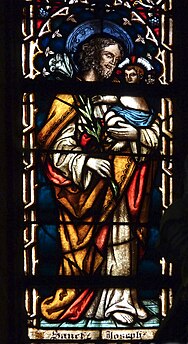St. Martin (Ediger)
St. Martin is a Catholic parish church in the Ediger district of the Ediger-Eller community on the Moselle. She belongs to the deanery of Cochem in the diocese of Trier . The structure lies on a rock on the mountain-side edge of the village. A corridor supported by consoles connects the church with the church gate of the city wall, which was built in 1363.
Construction and building history
A previous Romanesque building existed before 1097. Its foundations have been preserved, as has the choir with its north wall. The font in today's southern aisle also dates from the Romanesque period. St Martin was initially a branch church and was then elevated to a parish church in 1142 .
It was presumably in the 15th century that it was extensively redesigned and expanded into a two-aisled Gothic hall church . An older chapel on the north side of the choir was also enlarged in the 16th century.
1951 to 1953 the church received an extension to the north, whereby the old tracery windows were inserted into the new walls. St. Martin was extensively renovated in 1970 and 1974.
tower
The former Romanesque tower was given a Gothic successor 62 meters high in 1506. The west yoke of the south aisle adjoins it. Jodokus von Wittlich is considered a master builder.
The richly decorated octagonal spire is a specialty. Twelve decorative dormers are attached in the middle and upper area of the slate-covered helmet. At the corners of the base rise four four-sided steep pyramids, two of which each frame a transept . The elements are decorated with a number of finials , crosses, birds and stars made of lead. The lead ornaments are kept in red, gold and silver, the findings according to the original color (renovation 2003).
Interior and equipment
Three pillars support the richly branched star vault , which has a total of 117 keystones . On their reliefs are u. a. depicted:
Christ, the Mother of God with child in a halo , the apostles, several saints, the four church fathers , numerous craftsmen and house brands , the coat of arms of the Trier cathedral provosts as well as the jury seal of Ediger-Eller.
Nine figural vaulted consoles show u. a. a knight, two fools and the master stonemason.
Chapel north of the choir
- Stone relief "Christ in the winepress"
- A stone block by the Trier master Hans Ruprecht Hoffmann from the year 1600 shows St. Hilary on one side and Christ in the wine press , a motif of Christian iconography that emerged in the 12th century . It symbolizes suffering and joy. The pressed wine represents the blood of Christ. The grape must first be crushed before it becomes wine.
- Entombment group
- The work dates from 1671 and is based on the Münstermaifeld model.
- Man of Sorrows
- The figure goes back to around 1500.
Other equipment
A Pietà and a wooden crucifix also date from the late Gothic period , while the rest of the furnishings date back to the 17th and 18th centuries. These include a Vesper picture , the statue of the church patron St. Martin from 1741, the high altar, two side altars and the pulpit.
window
Most of the windows date from 1962–1963 and were designed by Rudi Schilling. There are also some older stained glass: In the east there are windows from the 19th century. In a choir window fragments from the 16th century show a blessing Christ, the cross lily on the north window also dates back to the 16th century.
organ
The organ is a work by the Stumm brothers from around 1775 with 19 stops on two manuals and a pedal . It was moved here in 1826 and restored in 1984 by Orgelbau Oberlinger . During a repair in 1833, Carl Heinrich Stumm from Rhaunen-Sulzbach was named as the “maker” of the organ.
Bells
St. Martin has six bells:
Hosanna (1411), Maria (1512), Martin (1512), Concordia (1564), Vox clamantis (1564) and Wolfgang (1995).
See also
swell
- Wolfgang Wolpert: Leaflet St. Martin zu Ediger on the Moselle.
- Information board at the church.
Individual evidence
- ↑ Information about the organ on orgbase.nl. Retrieved September 9, 2019 .
Coordinates: 50 ° 5 ′ 48 ″ N , 7 ° 9 ′ 24 ″ E










